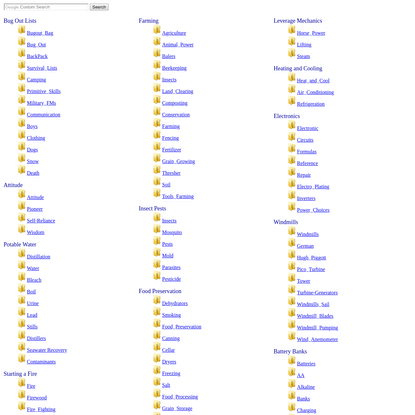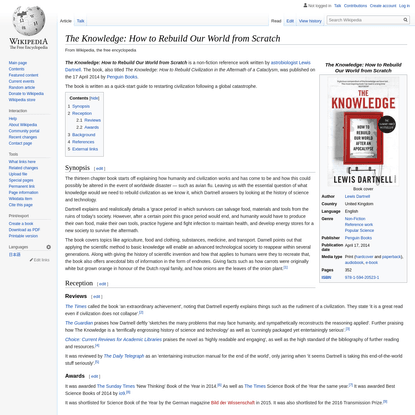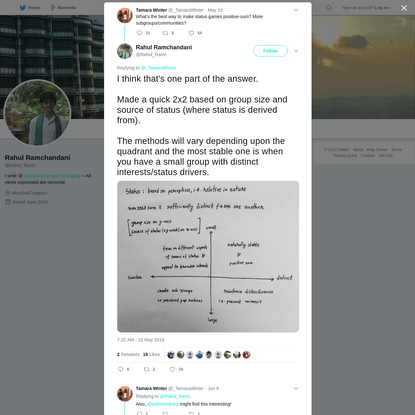Channels that seem to be related to the notion of creating sustainable resilient human environments. The hope is that these will be eventually mined and cataloged among the other content under this group.
Feel free to add yours.
What is "Homeostatic Mechanisms"?
About
[Homeostatic Mechanisms], or "HomeMech" for short, is an attempt at documenting and cataloging ways to bootstrap civilization.
It is a work in progress. At the moment is exists primarily a distillation of one person's obsession with rethinking the world we live in.
In its current form it explores of ideas, projects and initiatives that can help a local community become more resilient and thrive. Ideally this will turn into a standalone website that helps direct people by using Are.na as a sort of folk database via its API. Making these things accessible via Are.na directly is the next best thing, and so it was chosen as the place to hang these things on.
Longer term the hope is to create searchable discovery database. An interactive tool where you can input your existing constraints so it can show recommendations on projects & ideas that you or your group may want to look into.
Membership
My intention is to open the group up to other contributors down the road, but for the time being I am keeping membership closed. This is to avoid the chaos of organizing things while I work out better ways of structuring the content, and have some time to create guides for people on its use.
I welcome you to add relevant content (channels?) to the public channel and comments on blocks. I'll be combing thru these channels over time for more content and will be continuing to flesh out the group for the foreseeable future.
Please note when commenting that not all of the blocks originate from this space. The nature of Are.na means content exists independent of the channels.
Known Biases
There is a bias toward 'off-grid' environments, camping / 'primitive' technology, low cost, and a practical slant of trying to re-purpose waste materials. As a personal passion project, it is (currently) limited by the nature of living within the backwoods of Vermont and the associated climate/biome/resources {Temperate Forests, Green Mountains/Appalachia, Long travel distances, High fuel costs, and a wide range of weather/temperature conditions}.
At the moment it only looks at western society, viewing its trash as just another resource to make things from. It doesn't concern itself with aesthetic qualities or judgement on taste/fashion. It is also aimed primarily at poverty situations, with a strong slant of 'Jugaad' and various hacker/maker mentalities.
Ethos
[Bootstrapping Civilization]
Most human problems don't go away when we colonize.
To build toward Mars, build for home first.
So if we solve for problems that you'll face on mars, you may get solutions that work well on earth.
I want robotic ants on mars.
I can't do it alone = I need people to help
∴ I need 'tools for thought' & people to not die.
High Level Organization
Simple Critical Infrastructure Maps
The initial organization of this Are.na Group is loosely based on a the "Simple Critical Infrastructure Maps" from resiliencemaps.org. [HomeMech] can be considered an attempt at building out an interactive 'Hitchhiker's Guide' for exploring ways of acting on the problems the [SCIM] system is intended to highlight.
Simple Critical Infrastructure Maps [SCIM] are a way of framing resilience of human systems. A framework for exploring the way that different human artifacts, infrastructure, institutions, and other constructs allow for 'homeostasis' at the personal (and group) level.
You can view a collection of resources in a channel on the [SCIM]. You may prefer to just to read a 16 page overview/presentation on the [SCIM] idea.
At a fundamental level the [SCIM] system is an exploration of what it takes to support and continue human life. It doesn't explicitly call it homeostasis, but starts out at '6 ways to die' and works itself backward toward the various infrastructures & institutions that allow us to collectively avoid failure states.
The purpose of the mapping and its categories is to help shed light on the weaknesses of a given survival system, and try to pinpoint ways that existing systems can be made more resistant to failure. You can think of it as a way of applying first principle thinking on what it takes to keep humans alive. As such it also serves as a good framework for exploring how to [bootstrap civilization].
The main map for the homeostasis aspects is sometimes called "The Dartboard of Death" because of the shape resembling a dartboard. It also implicitly highlights the various ways that a group of humans can be diminished or outright destroyed. Having a shared map of where a community is weakest allows a group to work toward strengthening it.
Guiding Focuses
One of the main goals for this project is to create a way to quickly narrow down things you can do based on your skills, resources, and other relevant constraints. I have yet to find an easy to use way to represent this kind of analysis, but by storing it on Are.na my hope is to use the API to try and construct one.
By storing these ideas here, it can also leverage the social sharing aspects of Are.na, providing a collaborative way to access and share to these ideas in the meantime.
Critical Path
Figuring out what you can/should do given resources at hand is very similar to the problems faced by project managers who build out Gantt charts, find Critical Paths, and plan around Risks such as lack of knowledge, or uncertainty. Only in this case I think of the outcome not as a product release, but as an end goal of getting a more sustainable distributed future.
I've been looking at it from the perspective of constraints and constraint solving. The constraint-solving idea and stuff like "planning engines" notions from software and engineering are well known, but not accessible to the average person.
The intent is to label the various constraints so that you can optimize what you're doing. Where having something (a candle) is satisfied by making something (candle mold, wax, string), which is satisfied by knowing + doing (knowing how to make {molds, wax, string} + time resource and energy to do so). The idea here is to have abstract notions like 'knowledge' and 'time' as a first class citizen within the constraint solving process so you can plan around learning and build out access to expertise/skills.
Constraints
An evolving set of things to consider when exploring a project. No particular order.
- Bootstrap-able
- Given very bare resources, is there an efficient path to realizing an idea?
- DIY
- Is this something you or a small team could feasibly do on your own?
- Repairable
- Can the artifact be repaired and restored with reasonable skill?
- Cheap
- Can it be done on a budget?
- Found materials
- Can it be built using scrap or easily gathered materials?
- Low Waste
- Does it result in low or no trash?
- Recyclable
- Can it be harvested for parts and turned into other things thru some process?
- Sustainable
- Can it persist itself over a long (or perhaps indefinite) period of time, (taking into account resources and maintenance costs).
- Low-environmental impact
- Does it avoid causing excessive/unrecoverable destruction to the environment.
- Synergistic
- How does it work with existing solutions and amplify output?
- User friendly / Trainable
- Can it be taught to novices, require minimal specialized knowledge, or have accessible documentation?
- Accessible
- How do mental and physical limitations affect the utility of an idea. Can it be modified or substituted with something else that fits the needs better?
Category/Ranking ideas
A loose collection of ideas of how categorizing/ranking various ideas may be useful.
Upfront Cost / Cheapness
Long term / maintenance Costs
bootstrap-ability
mobile readiness
DIY/repairability
potential returns on scale
network effects
synergies
skill level / skill set
time / effort
practice
team size
disability aspects (working arms / legs / feet / hands, ability to walk, bend over, pick stuff up, endurance/stamina, dexterity / motor control, vision, hearing, pain tolerance, focus, memory, sustained attention/motivation vs intermittent, high/low upkeep)
Materials needed / Resources
Environment (humid, wet, dry, arid, island, desert, climate conditions, plant growth, ground and flooding)
My body sucks at thermoregulation
at least when I'm asleep
either I'm waking up with cold extremities or I'm sweating so much that I wake up dehydrated
And when I wake up dehydrated I have brain fog for the entire day
I traced my families chronic cold extremities to poor blood vessel issues and blood flow problems. There are a number of different possible causes. I traced mine to metabolic disorder / pre-diabetes associated uric acid build up and mutations in smooth muscle that cause weird responses to temperature https://healthyliving.azcentral.com/effects-temperature-muscular-contraction-11504.html (edited)
I just started taking gensing and black cohosh, hoping that the effects it has on smooth muscle might improve bloodflow in the brain. There were some studies that suggested it improves negative symptoms in schizophrenia, and I think it's related to why symptoms seem to be stronger if you're diabetic
Some weird connections https://doi.org/10.1176/appi.neuropsych.12120395 and https://doi.org/10.1016/j.jocn.2005.10.017 that roughly fall out of my larger model of how hormones affect blood vessel weirdness.
My larger theory is it's due to a bunch of mutations that make me cold-adapted. All of my family's lineage comes from ares with mountainous cold regions with long winters.
I can go out in the snow in shorts and be fine for hours, lol.
Going Keto and upping trypophan has helped. I think higher blood acidity (SCFAs are acids...) helps the blood transport stuff like calcium/serotonin around better and improves oxygen flow in my body. I went from 96.8 basil body temp to 99ish and now my feet don't get cold.
I also recommend trying a wool blanket. It seems to wick moisure and sweat away and has been shown to improve sleep by a few minute because of dampening the impact of your body's temperature regulation.
It dries quickly so it also keeps you warmer when you're not sweating, its pretty neat.
Dehydration does all sorts of weird things sometimes - it can make the kidneys and liver freak out and affect hormone production. It seems to act on insulin and blood glucose as well, though I haven't wrapped my head fully around how.
Can't find the paper(s) off hand, but one of the things I found investigating my own issues was that serotonin, estrogen, and calcium (testosterone too ala cholesterocalcium binding) all seem to affect each other in relationship to impacting blood acidity and the ability of redblood cells to hold onto nutrients. My guess is that this is partly how the body decides to give oxygen to muscles via sensing lactic acid concentrations, but I don't actually know why.
Those all seem to play a big role in the signaling mechanisms that trigger smooth muscle tissue to contract (and by association affect bloodflow to brain).
I think this is why women can't hold their pee as well as men and why my family has bladder issues - smooth muscles are what help the bladder contract.




